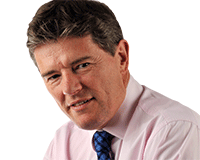 Deflation, the great fear for central bankers when the global financial crisis pushed the world economy into its biggest post-war downturn in 2009, became a reality in 2015.
Deflation, the great fear for central bankers when the global financial crisis pushed the world economy into its biggest post-war downturn in 2009, became a reality in 2015.
True, there was only a little bit of it; at their weakest, prices were down only marginally on a year earlier and the final reading for the calendar year is likely to be exactly zero.
So how will we remember 2015? Will we remember it as a year of political surprises in Britain? Neither David Cameron’s outright majority in May nor Jeremy Corbyn’s election as Labour leader in September were expected, particularly the latter. It was a year when terrorism, in the Middle East and closer to home, became ever-present, with events in the Middle East sparking Europe’s biggest refugee crisis since the Second World War.
Worries about higher interest rates, widely predicted at the beginning of the year, proved unfounded, in Britain at least. The Bank of England could, in the end, list a number of reasons for not hiking rates.
High among them was the absence of inflation and the expectation that it will only slowly return to its 2% target. Weak oil prices, the main reason for ultra-low inflation, have meanwhile taken on an air of permanence. Bravely or foolishly, I used to predict a return to $40 (£26) a barrel when the price of oil appeared locked at well above $100. Hang around long enough, however, and every forecast will come right sooner or later.
Weak oil prices and the disappearance, for now, of inflationary pressures have had an impact on financial markets, and on investors. As I write this the FTSE 100 is trading in the lower half of the 6,000s and is 6% or so down on where it started 2015.
It has been the best of times and the worst of times for the stock market. In the spring it finally shrugged off the ghosts of 1999, rising to a level above its former peak at the end of last year, in fact rising to more than 7,100. Seldom, however, has the “sell in May and go away” adage been more true. Subsequent months have been pretty grim.
Gold, the traditional hedge against inflation, has also not been a good place to be. Though this year’s price fall has not been spectacular – a little over $100 an ounce so far – it followed big falls in earlier years. Bonds and cash fared better in 2015, thanks to the absence of inflation, but returns were nothing to write home about.
That leaves property. And, in this time of change, in this time of zero inflation, property has been something of a safe haven. Though we will not know the full picture until the early weeks of 2016, returns on property have been rather good in 2015.
JLL’s UK Property Index showed total returns of 15.4% in the year to the end of Q3, consisting of 8.8% capital value growth, 4.2% ERV growth and 6% net income. Property comfortably beat gilts and equities on both a total return and a yield basis.
Taking it down further, offices had a 21.3% total return in the year to the end of Q3, closely followed by 20.1% for industrial, with retail some way behind at 9.1%. Offices led the way in terms of both capital and rental growth. The fact that retail has been a laggard in what was a good year for sales volumes looks on the face of it surprising, but falling shop prices have taken their toll on turnover and competition remains tough.
Of course, it is not just commercial property that has been generating decent returns. While the buy-to-let sector is reeling from its second assault by the chancellor in the space of a few months, house price inflation has continued even at a time of zero general inflation. The most recent reading from the Halifax – while suggesting some slowing of the pace of price rises – showed a 9% rise in the 12 months to November.
It is not always the case that in times of uncertainty bricks and mortar will be a safe haven, but it often is. And it certainly was in 2015.
David Smith is economics editor at The Sunday Times










